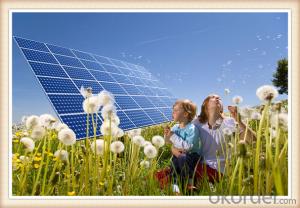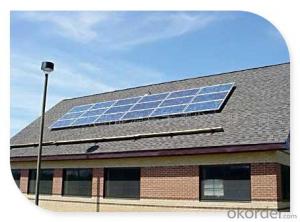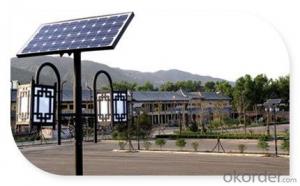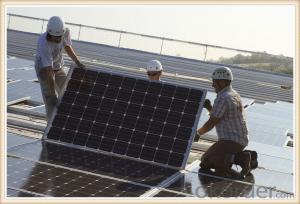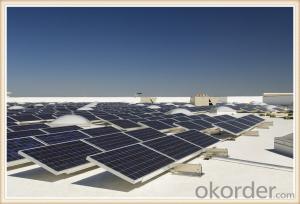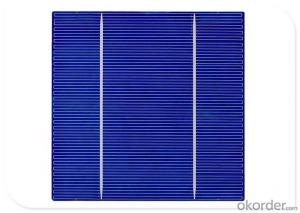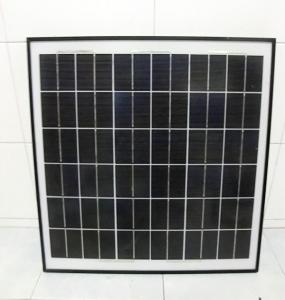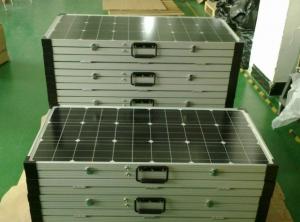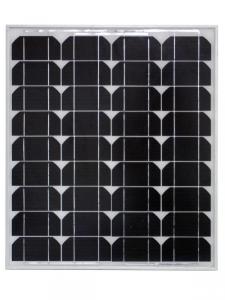Go Power Flexible Solar Panels - 105W Efficiency Chinese Solar Panels 5-200W
- Loading Port:
- China main port
- Payment Terms:
- TT OR LC
- Min Order Qty:
- 10000 watt
- Supply Capability:
- 100000 watt/month
OKorder Service Pledge
OKorder Financial Service
You Might Also Like
Specification
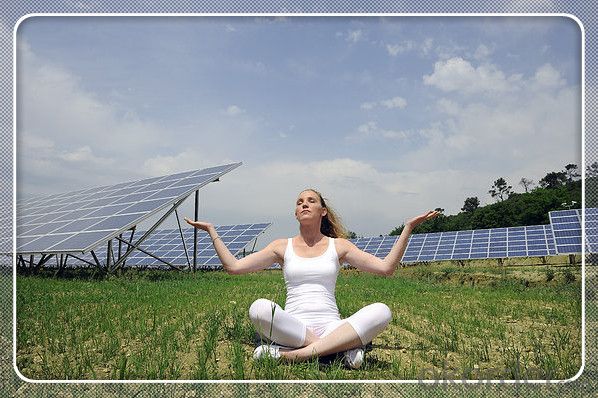
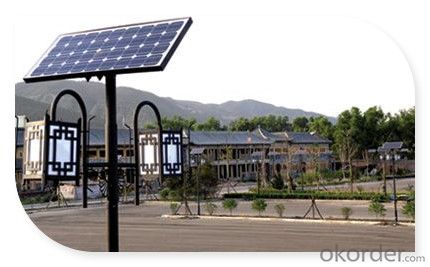
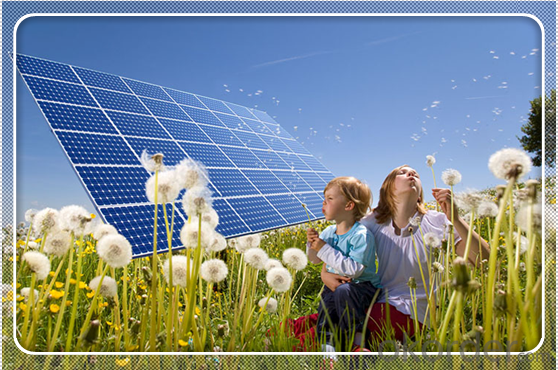
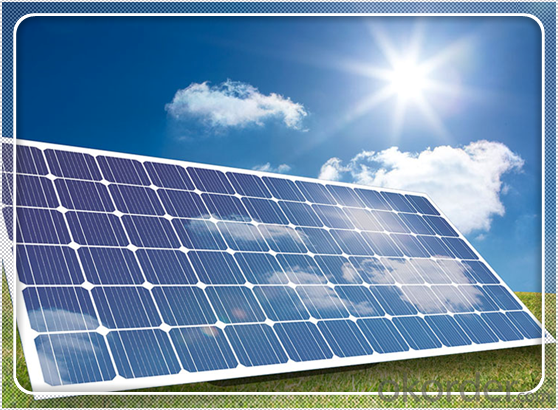
Solar Module Introduction
Solar Module is the core part of solar PV power systems, also is the highest value part of it. The function of Solar Module is to convert the sun's radiation to electrical energy, or transfer it to battery and store in it, or to drive the load running.
The Product has been widely used in space and ground, it mainly used for power generation systems, charging systems, road lighting and traffic signs areas. It could offer a wide range of power and voltage, and with high conversion efficiency, and long service life.
Solar modules use light energy (photons) from the sun to generate electricity through the photovoltaic effect. The majority of modules use wafer-based crystalline silicon cells or thin-film cells based on cadmium telluride or silicon. The structural (load carrying) member of a module can either be the top layer or the back layer. Cells must also be protected from mechanical damage and moisture. Most solar modules are rigid, but semi-flexible ones are available, based on thin-film cells. These early solar modules were first used in space in 1958.
Electrical connections are made in series to achieve a desired output voltage and/or in parallel to provide a desired current capability. The conducting wires that take the current off the modules may contain silver, copper or other non-magnetic conductive transition metals. The cells must be connected electrically to one another and to the rest of the system. Externally, popular terrestrial usage photovoltaic modules use MC3 (older) or MC4 connectors to facilitate easy weatherproof connections to the rest of the system.
Secification
Model Type | |
Peak Power-Pmax(W) | 5-200W |
Open Circuit Voltage-Voc(V) | 44.2 |
Maximum Power Voltage-Vmp(V) | 36 |
Short Circuit Current-Isc(A) | 5.4 |
Maximum Power Current-Imp(A) | 5 |
Maximum System Voltage | 1000V DC |
Maximum Series Fuse Rating | 10A |
Power Tolerance | -1~+3% |
Temperature Coefficients of Pmax | -0.45%/℃ |
Temperature Coefficients of Voc | -0.348%/℃ |
Temperature Coefficients of Isc | 0.031%/℃ |
Nominal Operating Cell Temperature | 44.5±2℃ |
Standard Testing Condition(STC) | Irradiance:1000W/m²;Temperature:25℃;AM=1.5 |
Qualification Test Parameters | |
Operating Temperature | -40℃~+85℃ |
Storage Temperature | -40℃~+85℃ |
Pressure Bearing | ≥5400Pascal/m² |
Wind Bearing | ≥5400Pascal/m² |
Mechanical Characteristics | |
Cell Size | Mono 125*125mm±0.5 |
No.of Cells | 72pcs(6*12) |
Dimension | 1580*808*40mm |
Weight | 15.5Kg |
Glass | 3.2mm High Transmission,Low Iron |
Frame | Anodized Aluminum Alloy |
Junction Box | IP65Rated |
Internal Diodes | 3 Bypass Diodes |
Cable | 1*4.0mm² Length 900mm |
Images
Packing & Shipping:
We have rich experience on how to pack the panels to make sure the safety on shipment when it arrives at the destination.
The normal size is packed by 25pcs/ carton / pallet. Paper carton for FCL shipping and wood carton for LCL shipping.
Warranty:
For c-Si panel: 25years output warranty for no less than 80% of performance, 10 years output warranty for no less than 90% of performance. Free from material and workmanship defects within 5 years.
For a-Si panel: 20 years output warranty for no less than 80% of performance, 10 years output warranty for no less than 90% of performance. Free from material and workmanship defects within 2 years.
FAQ:
(1)What price for each watt?
It depends on the quantity, delivery date and payment terms.
(2)What is your size for each module? Can you tell me the Parameter of your module?
We have different series of panels in different output, both c-Si and a-Si. Please take the specification sheet for your reference.
(3)Can you provide the peripheral products of the solar panels, such as the battery, controller, and inverter? If so, can you tell me how do they match each other?
Actually we are only manufacturer of solar panels, but we could try to source them for you in China if you need. We could provide you an optimal system design to instruct you how to install.
(4)Do you have the CE, TUV, UL Certification?
We’ve already passed all the tests, and any certificate is available.
(5)Have you ever sold your products to companies in my country?
Of course, we have customers in all general PV markets, but I think we should expand our market share along with the market growth.
(6)When did your company set up? You are a new company, how can I believe your quality?
We entered into Solar PV industry in 2005, now we have several plants in manufacturing of a-Si and c-Si panels, and our capacity is 220MW per year. Till now we have already passed all the tests by authorized laboratories, e.g. TUV, VDE, UL.
(7)Can you help us install the module if we cooperate with you?
We haven’t entered into installation sector, but we have the plan in near future.
(8) How do you pack your products?
We have rich experience on how to pack the panels to make sure the safety on shipment when it arrives at the destination.
(9) Can you do OEM for us?
Yes, we can.
(10)Can we visit your factory?
Surely, I will arrange the trip basing on your business schedule.
- Q: Can solar panels be installed on a golf course or clubhouse?
- Yes, solar panels can be installed on a golf course or clubhouse. The large open spaces and ample sunlight make it an ideal location for harnessing solar energy. Installing solar panels can help generate clean and sustainable electricity, reducing reliance on traditional power sources and potentially lowering energy costs for the golf course or clubhouse.
- Q: Hi, I want to put some solar light in my yard, and wondering if a 00w solar panel could work for a few 3w dc lights....do i need a battery so they run at night, if so how many lights do u think i can run/ also i see elading solar light
- 3 w for 2 hours/night is 36 watt hours. You'll get about 500 watt hours/day from your panel on the average, which for a 2 volt battery is about 40 ampere hours. You can get an 80 amp-hour sealed gel cell battery to charge with this panel (with a suitable charge controller). You want to size your lights so the battery can provide three days of light without discharging it more than 50%, so that's abnout 600 watt-hours/3/36 = about 4 orf 5 lights. Cost for this system woulkd be over $500. The advantage of the self contained light is they use a lithium or nickel battery rather than a lead acid, so it can run totally dead without damage (unmlike a sealed lead-acid battery). That would be a far cheaper way to go. DK
- Q: I contend:As far as the solar panels causing global warming I'll try to explain. If you put a black panel on the ground or on your house and don't connect it to anything, it will absorb solar energy (heat) during daylight and release it at night (radiation). The net heat gain is zero. If you hook up a solar panel in the same place but hook it up to batteries, charge the batteries during sunlight hours and using that energy to electrically heat the home at night. The panels will absorb solar energy during the day but will convert that to electrical energy in the batteries instead of radiating it back into space at night. The result is a net gain in earth's temperature.Right or wrong?
- Third Law of Thermodynamics (in normal speak): “Not only can you never get ahead, you can’t even break even.” This is a truism that applies to all activities involving energy exchange (and almost everything else as well). Energy in the form of solar radiation falls on the earth. That energy is absorbed by the planet (everything) and heat results. Some portion of that energy is lost in the absorption process and the net released as heat is less than that absorbed from the sun. This is true in all cases. Solar panels, both photovoltaic and heat collectors are subject to the Third Law and they all lose some of the radiant energy striking them in the process of converting that energy into either hot water (or whatever fluid) or electrical energy. Regardless of the process there is always a net loss of energy. The time delay you mention has no bearing on the total heat gain or loss for the planet. In fact the “solar panel effect” reduces the net energy put back into the ecosystem because it introduces another iteration of energy loss through conversion. The Holy Grail of energy conservation it the ability to use, store or recover the entire amount of energy produced regardless of the source of that energy, burning hydrocarbons, geothermal heat exchange, solar radiation, mice on treadmills …..all forms of energy suffer a net loss in any exchange! If we could avoid that loss we could dramatically reduce the heat lost into the atmosphere or ground water and our net energy gain would also be dramatic! Check out the super cooled circuits in use to reduce resistance in sophisticated electronic equipment for a good example of the energy savings. (Of course the savings do not account for energy lost in the cooling process. In any event NO….. solar panels do not contribute to global warming via their operation. (Their manufacture is another story altogether!)
- Q: Can solar panels be used for satellite communication?
- Yes, solar panels can be used for satellite communication. Solar panels are often used to power satellites as they can convert sunlight into electricity. This generated electricity can then be used to operate various communication systems and equipment on board the satellite, enabling satellite communication.
- Q: Can it be used on a cellphone so u never have to worry about low battery?
- What a solar panel REALLY is is a political rip-off in which the government takes money from me to help you buy solar panels that produce a fraction of the power you could have bought with the money they stole and which required more volatile chemicals to manufacture than would have been created in the consumption of that same power.
- Q: Can solar panels be installed on a university campus or educational facility?
- Yes, solar panels can be installed on a university campus or educational facility. In fact, many universities and educational institutions have already embraced solar energy as a sustainable and cost-effective solution for their energy needs. Installing solar panels not only reduces the environmental impact of the facility but also provides an opportunity for hands-on learning and research in renewable energy for students and faculty. Additionally, it can help save on energy costs and provide a reliable source of clean energy for the campus.
- Q: I found portable solar panels used for boats etc. and was wondering how I could effectly use them for my home instead. If you have used them in the past, please tell how they worked (good or bad).
- from what i have seen and heard the portable panels you are talking about are not big enough for home use unless you create a specific outlet to use them on such as one for cellphone charger or other small use items. Just my semi-educated guess.
- Q: Can solar panels be installed on remote monitoring systems?
- Yes, solar panels can be installed on remote monitoring systems. Solar panels are a sustainable and reliable source of energy that can power remote monitoring systems, allowing them to operate independently from the electrical grid. This makes solar panels a suitable and practical solution for remote locations where access to electricity may be limited.
- Q: hey, i am wanting to help our earth a little bit, and I was wondering how to do a solar panel connection for powering my home.... i just want to reduce my energy bill a little bit, Would these solar panels work?and how would i connect them?
- Hello, Yes you definitely can use this kind of panels. Powering your home entirely will be an issue if you are not familiar with solar energy and electricity in general. If it's the case I'm afraid you'll need a specialist. The basic principle of a solar power system: - Solar panel to charge the batteries - DC to AC converter that will convert the DC voltage from your battery to AC voltage so that you can connect regular home appliances like lights or TV.
- Q: I have in mind a small solar panel that could be plugged into a wall socket. Do I need a converter or some kind of interference between the two power sources so there aren't any unpleasant explosions? I don't know much about this sort of thing so please be nice.
- The other responders have given partial information. The electricity in your house is 20 volts AC and the solar panel will produce DC voltage. If you plugged in the solar panel into the wall, the solar panel would be destroyed, possibly with disastrous results. If you connected the solar panel to a DC to AC inverter, there are also dangers. The solar panel unless very large will not produce enough power to make a lot of AC, for every amp of 20 volt AC, you require more than 0 Amps of DC voltage. So most small solar panels are used to trickle charge a 2 volt battery used in backup situation. The problem is that the house AC and the inverter AC have to be exactly in phase or again you have disastrous results. If they are exactly 80 degrees out of phase, the wires now are carrying 240 volts and you will burn out the inverter, and possibly cause a fire. There are systems that will synchronize an inverter to commercial power so that you can feed the power back to the grid, but these are more complicated. If you want to use the battery and solar panel to run some lights during power failures, then you can connect the light to the common terminals of a switch, but the switch must be a break before make switch, which means that when you throw the switch the common is disconnected from the one source before it is connected to another source. Most AC switches will do this, but make sure.
Send your message to us
Go Power Flexible Solar Panels - 105W Efficiency Chinese Solar Panels 5-200W
- Loading Port:
- China main port
- Payment Terms:
- TT OR LC
- Min Order Qty:
- 10000 watt
- Supply Capability:
- 100000 watt/month
OKorder Service Pledge
OKorder Financial Service
Similar products
Hot products
Hot Searches
